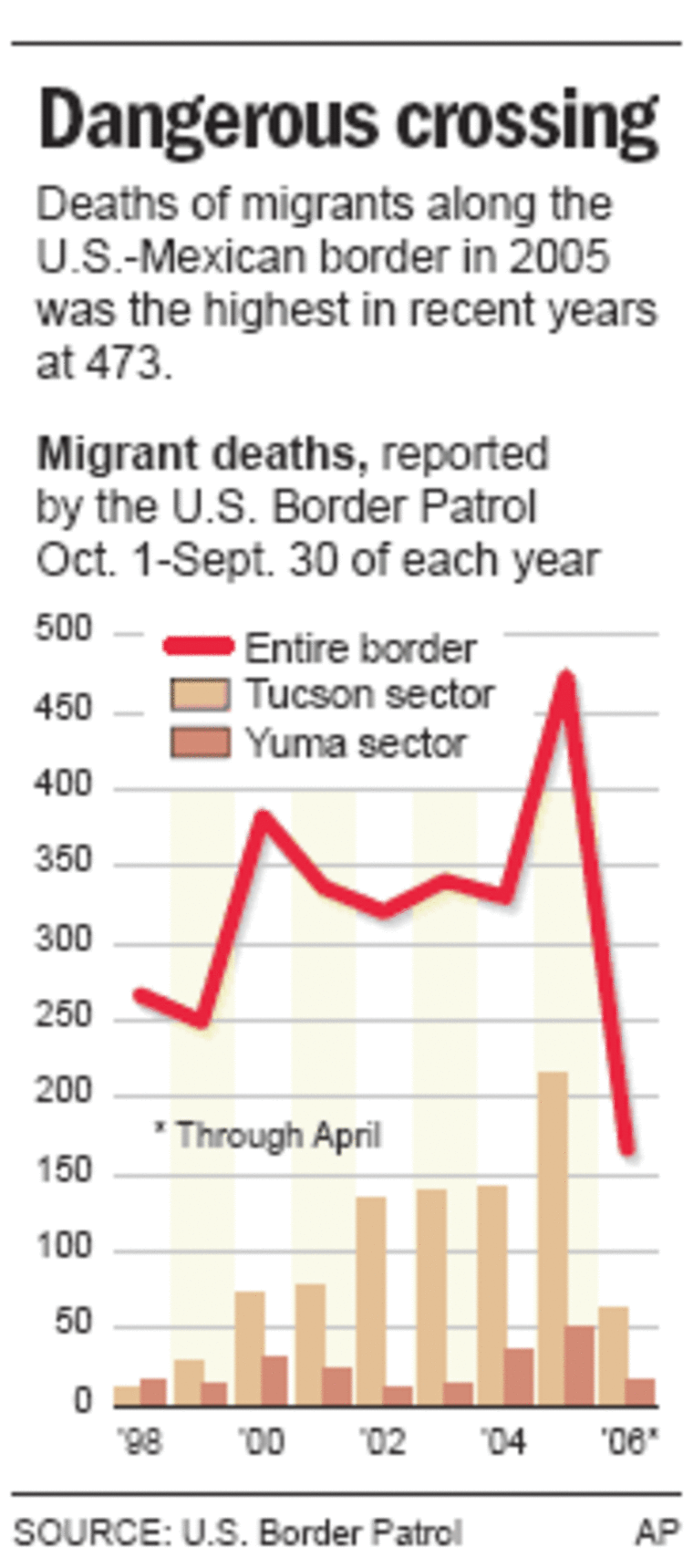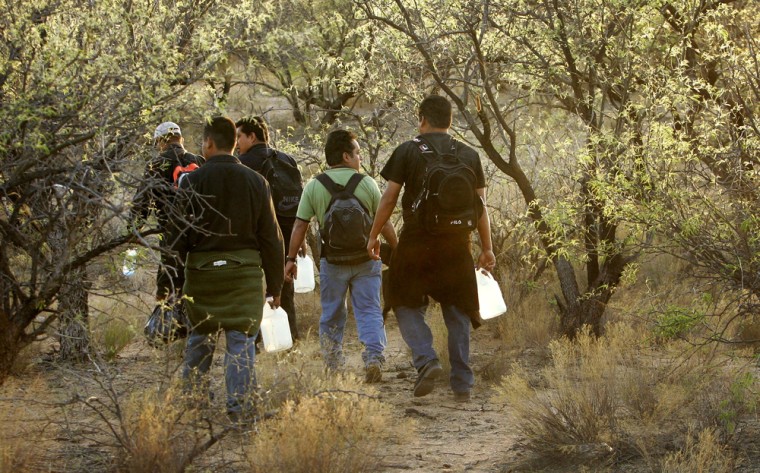Wearing tight jeans and a glittery “bebe” T-shirt, the 17-year-old scrambled out of a packed van as the temperature edged toward 90 degrees in this barren stretch of the U.S.-Mexican border.
Carrying no hat or sunscreen, the teenager who called herself Adriana Brenda said the longest hike she’d taken was through a shopping mall. But here she was, ready for a three-day trek across the desert.
She carried two gallons of water — enough, experts say, to keep her hydrated for two hours.
As temperatures rise, the U.S. Border Patrol and aid groups are gearing up for what they fear could be one of the deadliest summers for migrants sneaking into the United States.
The U.S. Senate is debating a bill that could lock the border tighter than ever, and activists fear the flow of migrants is moving to an even hotter and more remote section of desert than the current favorite, an area south of Tucson, Ariz., where hundreds of people have died since 1994.
Crossing near Yuma
The desert around Tucson is crawling with 2,400 U.S. Border Patrol agents. Rifle-bearing civilians known as Minutemen are also keeping watch.
In response, many migrants are crossing closer to Yuma, Ariz., where daytime temperatures can hover around 120 degrees — 10-15 degrees hotter than around Tucson.
Migrant deaths for the Yuma sector hit a record 51 in 2005, up from 36 in 2004 and 15 in 2003, according to the Border Patrol.
Apprehensions have jumped 16 percent for the region — with 89,336 people caught from October through April, said Richard Hays, a spokesman for the Border Patrol in Yuma.
“We are already anticipating this shift in traffic and are working to ensure the safety of those who are determined to get into the United States in violation of the law,” he said.
Those plans include erecting seven more rescue beacons in the Yuma sector — there are now 12 — and adding agents, Hays said.
Migrants have moved to more remote areas each time the U.S. has cracked down on a section of the 2,000-mile-long border, activists say.
Desert's brutality
The desert east of Yuma is one of the least forgiving. From the border, a migrant can walk for 50 miles before reaching an interstate.
In 2001, one of Arizona’s worst migrant tragedies occurred in the area, when 14 people died in temperatures reaching 115 degrees.

Adding to the danger is the Barry M. Goldwater Bombing Range, where the U.S. Air Force drops bombs to train for the war in Iraq.
Last year, Border Patrol agents rescued five children, five women and four men from the bombing range after their smuggler abandoned them and they activated a rescue beacon. No one has been hit by a bomb, Hays said.
Migrant groups estimate 500 people died trying to cross the border in 2005. The Border Patrol reported 473 deaths in the fiscal year ending Sept. 30.
While that number includes people who drowned in the Rio Grande, died in car accidents and succumbed to cold, the desert’s searing heat takes the heaviest toll.
In southern Arizona, Border Patrol agents routinely run across people vomiting uncontrollably in the summer heat, their skin clammy, their eyes glazed over, said Aerr Eltringham, a Border Patrol spokesman in Tucson. Some migrants are found dead.
Pamphlets with warnings
On a recent afternoon, agents for the Mexican government’s Grupo Beta aid group distributed pamphlets to migrants preparing to cross. The pamphlets recommend carrying plenty of water, food and salt, and advise migrants to keep their clothing on to avoid dehydration and sunburn. If the heat gets to be too much, the pamphlets advise setting a fire to summon rescuers.
Brenda, the 17-year-old in the “bebe” T-shirt, stuffed the pamphlet into her backpack and said she didn’t think the trip would be so hard. However, the teenager from the central city of Puebla admitted she had little experience in the outdoors.
“My parents warned us about the risks along the way, that you suffer cramps and get tired, but I have food and water,” said Brenda, who set out last week with her 18-year-old sister and about 16 other migrants on her way to Mesa, Ariz., where her brothers live.
“We’re doing this so we can have a better life,” said Brenda, who may not have given her full name for fear of being found by U.S. officials. It was impossible to determine if she successfully made the crossing. The Border Patrol does not confirm the names of detainees for privacy reasons.
For some, nights worse than days
Alejandra Valenzuela, 27, said her group used mountain bikes to move across the rugged terrain. But she and another woman couldn’t keep up, and the smuggler and other migrants wouldn’t wait.
She said the cold desert nights were worse than the baking sun.
“It was the coldest I’d ever felt in my life. I spent the night hugging that woman,” said Valenzuela, pointing to a woman sleeping on a nearby bunk at a shelter in the border town of Nogales.
After spotting what she believed was a coyote and hearing snakes hiss nearby, the women found a highway and waited for the Border Patrol.
“I thought I would get to the other side and everything would be beautiful, and I could buy all kinds of nice things,” Valenzuela said. “But you have to suffer so much, it’s not worth it.”
